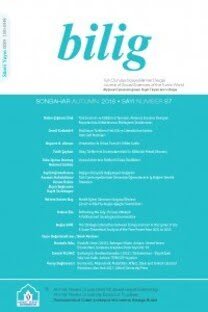Kazak At Kültüründe Dil ve Bilinç
at kültürü, ulusal bilinç, dil, etnolinguistik, Kazakistan
Language and Identity in Kazakh Horse Culture
horse culture, national identity, language, ethnolinguistics, Kazakhstan,
___
Baitelieva, Zh. (2007) Ethno-cultural motivation of phraseological combina- tions, connected with a horse in the Kazakh language. PhD Thesis. Al- maty.Beisenova M. S. (1995). Mahmud Qashqaridin “Divani Lugat it-Turik” de- gen enbegi boyinsha tort tulik mal ataulari turali zertteuler. PhD The- sis. Almaty.
Brown, R. (1976). “Reference: In memorial Tribute to Eric Lenneberg”. Cognition (4):125-153.
Cohen Y. H. E. (2011). “Atatürk and Erdoğan: Islam’s Impact on Turkish Nationalism”. Peer Reviewed Academic Journal 1(2): 46-74.
Conner, W. (1994). “A nation is a nation, is a state, is an ethnic group, is a…”. Nationalism. Eds. J. Hutchinson and A. D. Smith. New York.
Çinar A. (2001). Türkmen atı ve atçılığı. Istanbul.
Daniyarov, K. (1998). Al’ternativnaya istoriya Kazakhstana (Alternative his- tory of Kazakhstan). Almaty.
Drechsel, E. J. (1988). “Wilhelm von Humboldt and Edward Sapir”. Anal- ogies. Ed. W. F. Shipley. Berlin. 225-264.
Giddens, A. (2001). Sociology. Politics, 4th edition.
Johnson, D. I. (2006). “Music videos and National Identity in post-Soviet Kazakhstan”. Qualitative research reports in Communication 7 (Janu- ary): 9-14.
Kay, P., and W. Kempton (1984). “What is the Sapir-Whorf Hypothesis?”. American Anthropologist 86 (1): 65-79.
Kaydar, A. (1985). Ethnolinguistika (Ethnolinguistics), Scientific Journal of Bilim and Enbek 10: 18-22.
Konrad-Koerner, E.F. (1992). “The Sapir-Whorf Hypothesis: A Preliminary History and a Bibliographical Essay”. Journal of Linguistic Anthropol- ogy 2 (2): 173-198.
Kononov A.N. (1978). Semantika tsvetooboznachenii stran sveta v kazakhs- kom yazike. (Semantics of the meanings of color in Kazakh language). Turkologicheskii sbornik (Turkological collection) 1975. Moscow.
Kononov A.N., Nigmanov H.G. (1981). Mahmud Qashqariskii o turskih yazikah (Mahmud Qashqari’s work about Turkic languages). Journal of Istoriya lingvisticheskih uchenii: Srednevekoviy Vostok. Leningrad.
Mattoso-Camara Jr.J. (1970). “Wilhelm von Humboldt et Edward Sapir”. Actes du Xe Congres International des Linguistes. Eds. Alexandru Graut et al. Bucharest, 28 aout – 2 septembre 1967, Vol. 2. (Editions de l’Acad de la rep. socialiste de Roumanie). 327-332.
Nasimov D.N. (1981). Lingvesticheskiye vzglyadi Alishera Novaii (The views of Alisher Novaii about linguistics). Journal of Istoriya lingvisticheskih uchenii: Srednevekoviy Vostok. Leningrad.
Outram, A. K., Stear N. A., Kasparov A., Usmanova E., Varfolomeev V., and Evershed R.P. (2011). “Horses for the dead: funerary foodways in Bronze Age Kazakhstan”. Antiquity 85: 116-128.
Qashqari M. (1997). Turik sozdigi (Divani Lugat it-Turk) (Turkish dictio- nary). Vol. 1, 2. Almaty.
____ (1998). Turik sozdigi (Divani Lugat it-Turk) (Turkish dictionary). Vol. 3. Almaty.
Radlov V.V. (1893-1911). Opit slovariya turkskih narechii. (Experience of dictionary in Turkic expressions). Vol. 1-5. Saint Petersburg.
____ (1905). “Qazaqtardin maldari (the cattle of Kazakh)”. Journal of Eth- nografy 3. Saint Petersburg.
Sapir, E. (1921). Language: An Introduction to the Study of Speech. New York.
Sarbassova, G. (2010). Ethnolinguistic description of measuring names in Ka- zakh and Turkish languages. PhD Thesis. Almaty.
Sarsembayev, A. (1999). “Imagened communities: Kazak nationalism and Kazakification in the 1990th”. Central Asian Servey 18: 319-346.
Seyfulliin, S. (1964). Shygarmalar. Vol. 6. Almaty.
Smith, D.A. (1991). National Identity. Middlesex.
Sürürcü, Ç. (2002). “Modernity, nationalism, resistance: identity politics in post-Soviet Kazakhstan”. Central Asian Servey 21 (4): 385-402.
Toqtagul B.S. (2005). Turki tilderindegi tort tuliktin zhasina katisti ataular- din ethnolinguistikalik sipati. PhD. Thesis. Almaty.
Toktabai A. and Zh. Seytkulova (2005). Tort tuliktin qasiyeti (Characteris- tics of horse, camel, caw and sheep). Almaty.
Toktabai, A. (2010). Phenomenon of a horse in traditional culture of Kazakh people. PhD. Thesis. Almaty.
Young C. (1993). “The dialects of cultural pluralism: concept and reality”. The Rising Tide of Cultural Pluralism: the Nation State at Bay?. Eds. Young C. Madison. 1-36.
Zardykhan, Z. (2004). “Russians in Kazakhstan and demographic change: Imperial legacy and the Kazakh way of nation building”. Asian Eth- nicity (5): 61-79.
http://www.britannica.com/EBchecked/topic/523671/Edward-Sapir (22.01.2013).
http://en.wikipedia.org/wiki/Tengri (12.03.2013).
http://www.akorda.kz/ru/category/kazakhstan_gerb (25.07.2013).
- ISSN: 1301-0549
- Yayın Aralığı: Yılda 4 Sayı
- Başlangıç: 1996
- Yayıncı: Ahmet Yesevi Üniversitesi
Türkiye’de Başkanlık Sistemi Tartışmalarının Yakın Tarihi: Özal ve Demirel’in Siyasi Mülahazaları
Kırgızistan’da Televizyon İzleme Davranışı Örüntüleri: Bir Kullanımlar ve Doyumlar Perspektif
Buhara - Afganistan - Türkiye Üçgeninde Mangıt Hanedanı’nın Dil ve Aidiyet Durumu
Yüzyıllık Süreçte Tevfik Fikret’in Şermin Yapıtı Bağlamında Diliçi Çeviri ve Yanmetin Olgusu
Neslihan KANSU-YETKİNER, Nihal YETKİN-KARAKOÇ
Bulgaristan’dan Türkiye’ye Gelen Göçmenlerin Yaşam Profillerinin Memnuniyet Durumlarına Etkisi
Latife UTAŞ AKHAN, Makbule BATMAZ
Avrupa Komşuluk Politikası ve Azerbaycan: Eleştirel Bir Değerlendirme
Geçiş Ekonomilerinde Vergi Kültürü ve Etkileyen Faktörler: Kırgızistan Örneği
Raziyahan ABDİYEVA, Tuncer ÖZDİL, Cusup PİRİMBAYEV
Tesettürlü Kadınlarda Öz Bakım ve Estetik Yönelimler
Sırderya Nehri’nin Aşağı Kısmındaki Kışlaklarının Yöresel Özellikleri (XIX – XX yy. ilk yarısı)
Zhazira TOLEUBAYEVA, Tattigul KARTAYEVA
Şiirlerle Yabancı Dil Olarak Türkçe Öğretimi: Sözcüklerden Farklı Dünyalara
